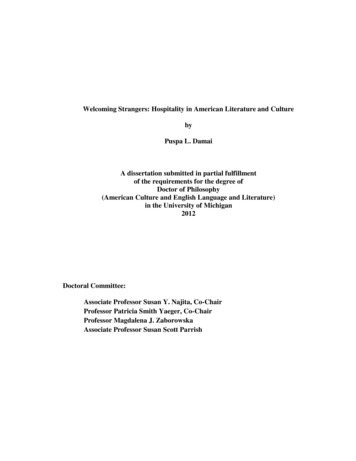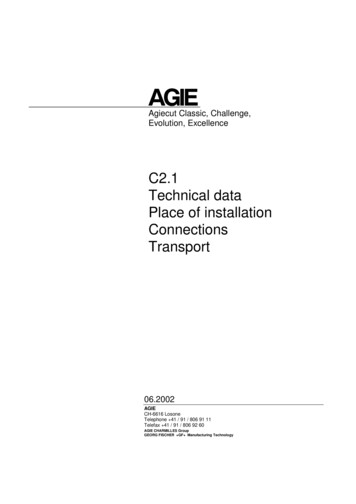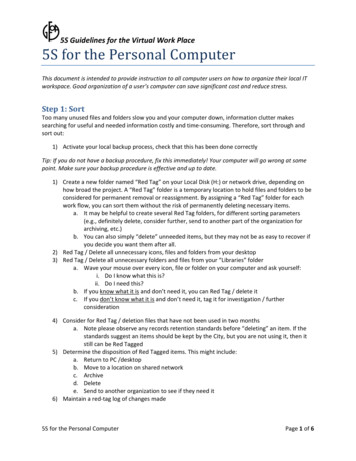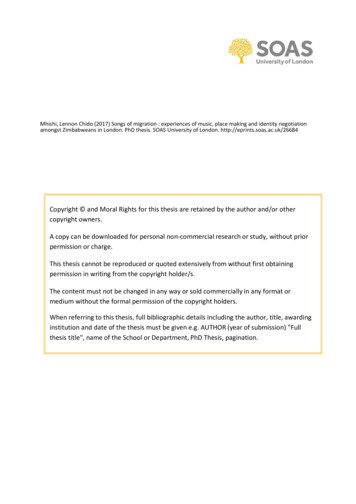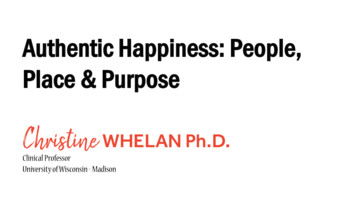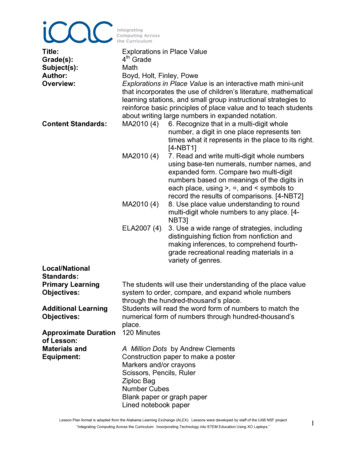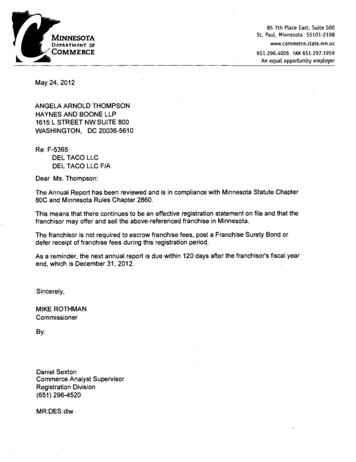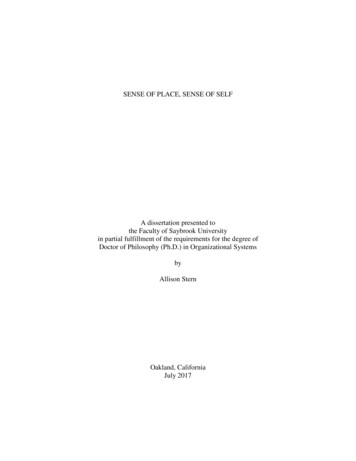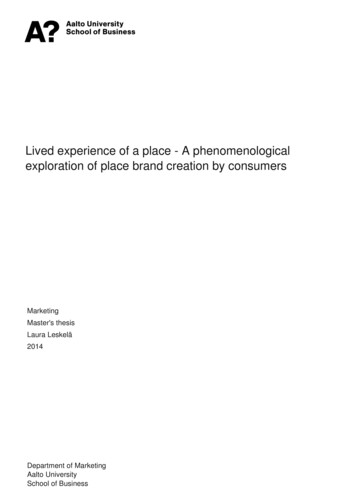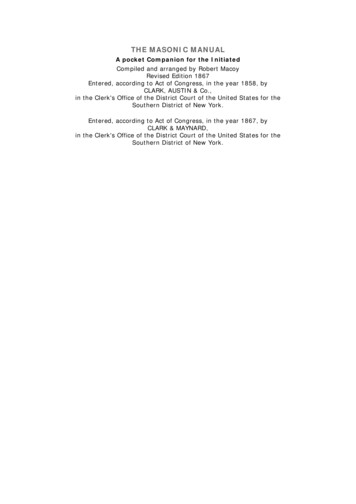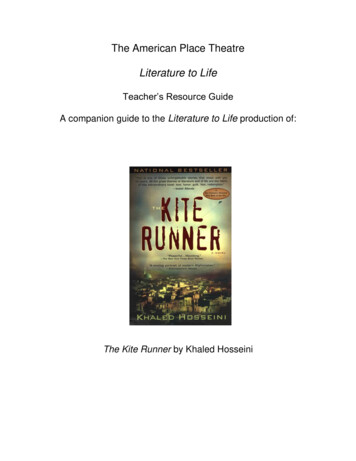
Transcription
The American Place TheatreLiterature to LifeTeacher’s Resource GuideA companion guide to the Literature to Life production of:The Kite Runner by Khaled Hosseini
Getting to Know Afghanistan50,000-20,000 BCE: Archaeological evidence indicates human civilization is beginning to thrive in thearea that will become known as Afghanistan.500 BCE: Persian leader Darius the Great extends his empire into modern-day Afghanistan.329 BCE: Alexander the Great conquers Persia and Afghanistan. Greek rule continues in much of thearea during the next two centuries, although unrest and revolts are common.50 AD: The Kushan empire and its Buddhist doctrines, begin to establish themselves in the region.550: After years of relative independence, Persian forces reassert control over the area but continue toface intermittent revolts from native Afghan tribes.652: Arabs introduce the region to Islam, a religion that becomes dominant.962: The Islamic era begins with the Ghaznavid founded by Turks and giving rise to Afghanistan’semerging role politically and culturally in Islamic civilization.1030: The Ghaznavid empire begins to fall apart after the death of Mahmud of Ghanzni.1370: A series of ventures to seize competing kingdoms and intermittent revolts mark the 14th and 15thcenturies.1504: Babur, a founder of India’s Moghul dynasty, takes control of Kabul and, in time, much of modernday Afghanistan. Moghul rule introduces another religion, Hinduism, to the country and sets off moreattempted nationalist revolts.1600s: On the heels of the nationalist movement of the previous century led by Bayazid Roshan, anothernationalist-minded revolt–this one headed by Afghan warrior-poet Khushhal Khan Khattak - beginsagainst the Moghul government in the late 1600s.1708: Mir Wais, considered by some the father of Afghan independence, successfully takes over Andaharin southern Afghanistan. His son, Mir Mahmud, invades Persia and liberates Herat. But by 1736, thePersians start to re-establish their grip on the region.1750s: Ahmad Shah Durrani begins his rule, consolidating and enlarging Afghanistan while alsogoverning much of India. But peace will be the exception over the next 100 years, as local leaders fendoff Persian and Sikh invasions and fight amongst themselves.1836: The British, in corroboration with ex-king Shah Shuja, invade Afganistan in response to growingRussian and Persian influence in the region. Afghan forces fight fervently against British forces, and thenation reasserts its independence.1878: The British launch their second war against Afghanistan, but withdraw in the face of strongresistance two years later.
1885: Russian forces seize territory in northern Afghanistan. The Russians will keep most of the area, butthereafter pledge to respect Afghanistan’s territorial integrity. Eight years later, another boundaryagreement–this one between Afghanistan and British India–leaves several Afghan tribal areas in what isnow Pakistan.1921: A third Anglo-Afghan war breaks out after anti-British forces assassinate the king. But by 1919,the war-weary British relinquish control over Afghanistan’s foreign affairs. The new king, AmᾱnullᾱhKhan, establishes diplomatic relations with several major nations and introduces reforms aimed atmodernizing the country. But the moves alienate many tribal and religious leaders and generate politicalturmoil1949: Afghanistan’s Parliament refuses to recognize new boundaries drawn by Great Britain establishingan independent Pakistan.1973: Daoud Khan and the Afghan Communist Party overthrow the ruling Afghan government and longtime king Mohammad Zahir Shah. Daoud abolishes the monarchy, presents a new constitution, oustssuspected opponents from the government and institutes economic and social reforms.1978: Daoud is killed and his government falls in a communist-backed coup. Mass killings, arrests andtortures ensue, and the Afghan guerrilla (Mujahidin) movement is born.1979: Anti-communist forces take control, prompting a Soviet invasion.1984: The Mujahideen, known by supporters as “Freedom Fighters,” begin receiving military andlogistical assistance from the United States and other countries.1988: The Soviet Union and United States sign the Geneva Accords, calling for Soviet withdrawal fromAfghanistan and the return of refugees without fear of persecution. But the Mujahideen do not take partin the negotiations, and do not accept it.1992: The Mujahideen take over Kabul and declare Afghanistan liberated. They form an Islamic state,headed by the Islamic Jihad Council and Professor Burhanuddin Rabbani.1994: The Taliban militia is born and begins to rise up against Rabbani’s government and its supporters.Over the next several years, the group will become a dominant political force, although by 2001 onlythree other countries recognize its legitimacy.2001: Afghanistan interim government is formed.2002: Hamid Karzai becomes President and peacekeeping forces enter the country.2004: A new constitution is introduced.
Pre-Show Activity: An Introduction to the AuthorObjective:The students will be introduced to author Khaled Hosseini and his novel, The Kite Runner.Students will use spatial relationships to the physical book to communicate their initial reactionsto text.Common Core Anchor Standards Addressed:SL.CCR.3: Evaluate a speaker’s point of view, reasoning, and use of evidence and rhetoric.L.CCR.1: Demonstrate command of the conventions of English grammar and usage whenwriting or speaking.1. Have volunteers read the following aloud:Khaled Hosseini was born in Kabul, Afghanistan in 1965. He is the oldest of five children, andhis mother was a teacher of Farsi and History at a large girls high school in Kabul. In 1976,Khaled’s family was relocated to Paris, France, where his father was assigned a diplomatic postin the Afghan embassy. The assignment would return the Hosseini family in 1980, but by thenAfghanistan had already witnessed a bloody communist coup and the Soviet invasion. Khaled’sfamily, instead, asked for and was granted political asylum in the U.S. He moved to San Jose,CA, with his family in 1980. He attended Santa Clara University and graduated from the UC SanDiego School of Medicine. He has been in practice as an internist since 1996. He is married andhas two children (a boy and a girl, Haris and Farah). The Kite Runner is his first novel.Excerpt from www.khaledhosseini.comDear Friends,Many readers see my novel, The Kite Runner, as a book about Afghanistan, a story of its violentrecent past, its tragedies and upheavals, culture and resilient people. They tell me that this bookopened for them an intimate window into my troubled homeland, and that news stories aboutAfghanistan suddenly registered with them on a deep and personal level. They ask me if thiswas my intent in writing this book. And I tell them it was. But not that first day, in March of 2001,when I sat to write the opening words of this book. For me, writing has always been, first andforemost, about storytelling. The Kite Runner came about simply because I was bewitched by astory. A story of guilt and redemption, brutality and kindness, sin and forgiveness, a story of thedoomed friendship between two boys, one rich, one poor, one flawed, the other pure, withAfghanistan and her own tale of brutality and kindness as the backdrop. It was always, first andlast, about story. And stage has always been a unique and powerful medium for storytelling,direct and intimate, organic and spontaneous. And so I thank American Place Theatre forselecting the story of Amir and Hassan, two boys who lived in my mind and are dear to myheart. I am grateful and thrilled. Thank you for honoring me with this performance tonight.Khaled HosseiniLetter written to The American Place Theatre - April 12, 20052. Spatial Activity:The group forms a circle, and a copy of The Kite Runner is placed at the center. Each person hasthe opportunity to place his/her body in relation to the book, thus expressing something abouthow they feel based on the information they have so far. For example, a person who still feels
s/he knows nothing about the book, but is interested in finding more out, may stand at a distancefrom the book and stare at it. A person who thinks s/he is going love it may cradle it in his/herarms. A person who thinks it’s going to be boring may turn his/her back to the book.Pre-Show Activity: Yes, No, Maybe SpectogramObjective: The students will make personal connections to the characters and themes in TheKite Runner by relating their experiences to the novel through a spectrogram activity.Common Core Anchor Standards Addressed:SL.CCR.1: Prepare for and participate effectively in a range of conversations and collaborationswith diverse partners, building on others’ ideas and expressing their own clearly andpersuasively.SL.CCR.2: Integrate and evaluate information presented in diverse media and formats,including visually, quantitatively, and orally.1. Students are told that the room is split up into three categories - Yes, No, and Maybe. Aquestion will be asked, and they will respond by moving to one side of the room if theanswer is “Yes,” the other side if the answer is “No” and the middle part of the room if theanswer is “Maybe, or I’m not Sure.” The students can also stand anywhere on thespectrogram between “Yes” and “No.”2. Read questions aloud. Questions start off general and then advance to those thematicallyrelevant to the novel The Kite Runner: Have you heard of the novel The Kite Runner? Do you know much about Afghanistan? Do you think that you have much in common with a student of your age livingin Afghanistan?Do you have a close childhood friend from whom you’ve grown apart? Do you have a close childhood friend with whom you still keep in touch? Have you ever had a good friend who was in a different social class? Have you ever had a secret that you didn’t share with anyone? Have you ever regretted a choice that you made? Have you ever felt like a “bad person”? Do you have a relative whom you admire? Do you think all people have flaws? Do you think it is ever okay to lie?Reflection:In small groups debate the last question, “Do you think it is ever okay to lie?” Have groupspresent their best arguments to the class. Have students defend a position opposite of their ownviews.
Pre-Show Activity: TableauxObjective: Students will collaborate to interpret text passages from The Kite Runner throughphysical images.Common Core Standards Addressed:R.CCR.2: Determine central ideas or themes of a text and analyze their development;summarize the key supporting details and ideas.R.CCR.7: Integrate and evaluate content presented in diverse formats and media, includingvisually and quantitatively, as well as in words.NYS Arts Standard 1.2: Imitate experiences through pantomime, play making, dramatic play,story dramatization, storytelling, role-playing, improvisation, & guided playwriting.Activity:1. Participants are broken up into small groups. Each group receives an excerpt from TheKite Runner and is asked to either literally or abstractly create a tableau (frozen image)which captures the essence of the excerpt. The teacher defines “tableau” for the studentsas a silent frozen picture using the physical body.2. Groups are given 10-minutes time to discuss their excerpt and collectively decide how tobest capture its imagery. They decide which characters are present in the tableau and areencouraged to be as creative as they wish, since they have not yet seen the performance.3. Groups will share their tableau with the class (possibly in chronological order). When theclass yells out in unison, “1-2-3 Freeze,” the group freezes into their tableau.4. As each group presents, the other participants try to figure out what is going on in theimage. Encourage the actors to hold their image and not react to how the group responds.5. Next, have participants think of a word or phrase that best describes what their characteris feeling. Give them 30 seconds to think of something and then have them go back intotheir image. When tapped they will speak out a phrase or sentence which gives a clue asto who they are in the tableau or what their character may be feeling.Examples of excerpts that can be used:I became what I am today at the age of twelve, on a frigid overcast day in the winter of 1975. Iremember the precise moment, crouching behind a crumbling mud wall, peeking into the alleynear the frozen creek. That was a long time ago, but it’s wrong what they say about the past,I’ve learned, about how you can bury it. Because the past claws its way out. Looking back now,I realize I have been peeking into that deserted alley for the last twenty-six years.Hassan and I used to climb the poplar trees in the driveway of my father’s house and annoy ourneighbors. I talked Hassan into firing walnuts with his slingshot at the neighbor’s one-eyedGerman shepherd. Hassan never wanted to, but if I asked, really asked, he wouldn’t deny me.Hassan never denied me anything. And he was deadly with his slingshot.During the school year, we have a daily routine. By the time I drag myself out of bed and lumberto the bathroom, Hassan has already washed the morning namaz with Ali, and prepared mybreakfast. I eat and complain about my homework, Hassan makes my bed, polishes my shoes,
irons for the day, packs my books and pencils. I hear him singing to himself in the foyer as heirons, singing old Hazara songs in his nasal voice. Baba and I drive off in his black FordMustang.At home I open the door to the smoky study Baba and Rahim Khan are drinking tea andlistening to the news on the radio. Their heads turn. Then a smile plays on my father’s lips. Heopens his arms. I put the the kite down and walk into his thick hairy arms. I bury my face in thewarmth of his chest and weep. Baba holds me close to him, rocking me back and forth. In hisarms, I forget what I’ve done. And that is good.Post-Show Activity: Role on the WallObjective: Students will explore the characters’ inner feelings and external influences in TheKite Runner.Common Core Anchor Standards Addressed:R.CCR.3: Analyze how and why individuals, events, and ideas develop and interact over thecourse of a text.R.CCR.6: Assess how point of view or purpose shapes the content and style of a text.Exercise:Students pick one character that they were introduced to in performance of The Kite Runner.Each student creates an outline of a body by drawing it onto a small poster board and decideswhich of the characters in the novel it represents.Students are told that on the inside of the body they should write words or phrases that capturethe internal world of the character including: Thoughts Beliefs Emotions Characteristics Secrets HistoryOn the outside of the body, they are asked to write words or phrases that capture the externalworld of the character including: What people think of this character What this character shows to the world Physical appearance of the character External influences or environment People and situations that the character interacts withDiscussion:1. What do these things tell us about this character?2. What does this person struggle with? Are there internal conflicts or relationship tensionsthat influence their choices?3. What questions do you still have about this person?
Post-Show Activity: Scene WritingObjective: Students will practice creating original thematic written material. The participantswill write and act out a theme-related, two-character scene.Common Core Anchor Standards Addressed:R.CCR.6: Assess how point of view or purpose shapes the content and style of a text.W.CCR.3: Write narratives to develop real or imagined experiences or events using effectivetechnique, well-chosen details, and well-structured event sequences.Exercise:1. Ask the class to brainstorm three categories–themes, characters, and settings–which arepresent in the novel and performance of The Kite Runner. Then, help students definethese terms and lists the students’ responses on the board under the three differentcategories.2. In groups of two, participants agree upon one theme, one setting, and two characters fromthe brainstormed lists that they would like to further explore.3. After the pairs have agreed on a setting, theme, and characters for themselves, theysilently write scene dialogue in the following way: using one piece of paper and one pen,each participant writes one line of dialogue and then passes the pen onto his/her partnerwho does the same.4. Each participant is responsible for his/her writing of dialogue and should not consulthis/her partner. The entire activity should be silent. Groups rehearse and present theirscenes.5. After the writing is complete, each pair will share their scene with the class.6. Discuss each scene: what was the theme? Was there conflict between the characters?What did each character want and why?Post-Show Activity: The Hot-SeatObjective: Students will demonstrate their knowledge of characters in The Kite Runner througha character interview.Common Core Anchor Standards Addressed:SL.CCR.3: Evaluate a speaker’s point of view, reasoning, and use of evidence and rhetoric.
SL.CCR.4: Present information, findings, and supporting evidence such that listeners can followthe line of reasoning and the organization, development, and style are appropriate to task,purpose, and audience.NYS Arts Standard 1.1: Use improvisation and guided play writing to communicate ideas andfeelings.Exercise:1. After each pair has presented their scene, the class will have the opportunity to interviewthem in-role as the characters.2. The class may ask the characters any questions that further their understanding of thecharacter, scene, and themes presented.3. The participants being interviewed must use their imaginations to answer the questions incharacter basing their responses on the information they have gathered from reading thetext and seeing the stage presentation.Final Reflection:During the interviews, did you make any new discoveries about these characters or theirrelationship to each other? What?What was most challenging about being interviewed as this character?What questions do you still have about this character?
Kite Runner and is asked to either literally or abstractly create a tableau (frozen image) which captures the essence of the excerpt. The teacher defines “tableau” for the students as a silent frozen picture using the physical body. 2. Groups are given 10-minutes time to discuss their excerpt and collectively decide how to best capture its .
